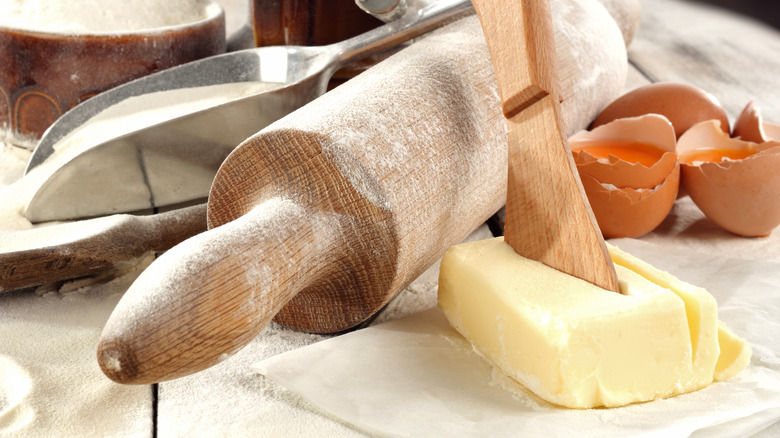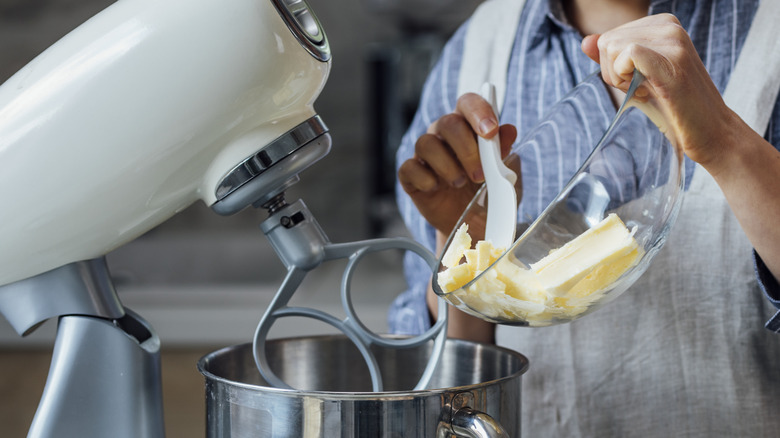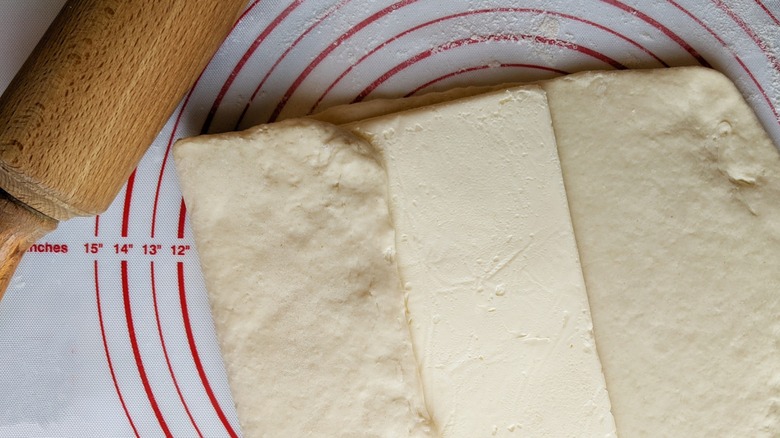A Rolling Pin Is The Key To Softening Butter In A Pinch
Butter is a baking staple, for cakes, cookies, breads, croissants, pie crusts, and more. But before it can be incorporated into doughs and batters for these treats, it has to be at the right temperature. Made of fats, milk solids, and water, butter is a fickle ingredient that, on the one hand, can melt alarmingly fast. However, when you need it to be a little softer butter can also have the frustrating tendency to remain firm (even when mixed), leaving batters lumpy.
While many sources advise leaving butter out at room temperature ahead of time to soften, this is not a foolproof solution. For one thing, it's a step that's easy to forget. Secondly, the effectiveness depends on the temperature in the room: butter will become greasy in hot, humid environments, and stay firm in cold ones.
Instead, reach for your rolling pin to help soften butter quickly and easily. The technique is simple: place a block or stick of butter between two pieces of wax or parchment paper positioned on a firm and stable surface. Then, hit the butter with the rolling pin, and keep on hitting until the butter is flattened into a pliable sheet. What you do with the butter next depends on what you're making.
Once pounded, butter is ready in just minutes
Once you've beat your cold, firm butter and flattened it into a thin sheet, cube it, and within a few minutes, it will be soft and ready to incorporate. If you leave it as a stick or block, it can take upwards of an hour to achieve the intended density. Best of all, the thin sheet of butter softens evenly all over; in contrast, some methods to soften (like microwaving or putting it under a warm glass) can leave pockets of cold or melted butter in the block.
Evenly softened butter is crucial in baking recipes for treats like cookies and cakes so that it'll easily blend with other ingredients — perhaps most importantly, sugar. Beating softened butter and sugar together, a process called creaming creates little air pockets in the mixture, which helps baked goods rise and gives them a light, airy texture.
For laminated doughs, the rolling pin makes butter easy to layer
Sometimes what you want from your softened butter is not to whip it up in a sugary cloud, but to be able to roll and fold it in layers with dough. This layering is crucial in laminated doughs, used to create beautiful, airy, layered pastries like croissants, Danish, kouign amann, cronuts, and palmiers.
For these recipes the butter needs to be both softened and cold — if the butter gets too warm it'll melt into the dough and ruin the texture. That's why using other softening methods, such as leaving the butter out on the counter or zapping it in the microwave, are too risky. Instead, the rolling pin offers the perfect solution. It can be used to quickly pound and soften butter into a thin sheet that has flexibility but is still cold. Once the butter is tucked into an envelope of dough, the rolling pin rolls and flattens them together. With repeated chilling, folding, and rolls from the rolling pin, the result is a dough with dozens of thin layers of cold butter that create a flaky, baked texture.
Go ahead and keep that butter in the fridge, knowing that a simple rolling pin is all it takes to speedily soften it for your baking recipes. As a bonus, whacking cold butter with a rolling pin is a satisfying way to work out any lingering vexations, too.


